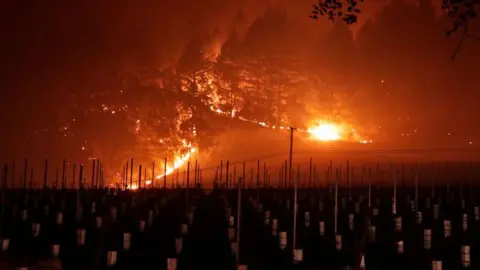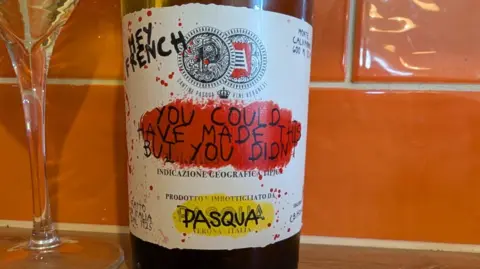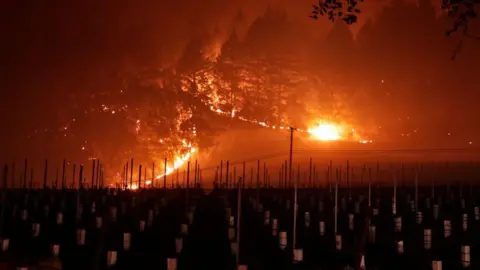In the world of wine vintage is king. If you are buying a bottle of red, white or rosé then the specific year of the grape harvest is almost always written on the label.
By contrast, non-vintage still wine – that made by blending two or more years – is seen as very downmarket, something cheap and not cheerful. And it is significantly rarer.
Yet with climate change hitting vineyards around the world with more extreme weather, a small but growing number of quality-conscious wineries are releasing non-vintage bottles so they can make a more consistent wine.
Chris Howell is the winemaker at Cain Vineyard and Winery in California’s celebrated Napa Valley region, 50 miles (80km) northeast of San Francisco. He has been in the job since 1991, and he says that summers have got noticeably hotter.
“Weather is a complicated thing,” he says. “The issue people are focused on most in Napa are dramatic heat spells, heat waves that generally come throughout the summer, particularly in late summer.
“They have been around for as long as I have been here, but the peak temperatures of these are higher. The heat can be intense. You can get as high as 50C, something near to that.”
With the higher temperatures comes the increased risk of wildfires. That was the case back in 2017, when he says “tremendously intense fires” broke out in Napa in the middle of the grape harvest.
That year Howell decided to only use grapes from Cain’s vineyards that had been harvested before the fires started, approximately half of the total, to prevent the risk of the smell – and taste – of smoke in the air from tainting the subsequent wines.
He says he is more “relaxed” than many winemakers would be about such a catastrophe, because he has long made a non-vintage red blend called Cain Cuvée. “So some of the wine we were able to make in 2017 was held over to be blended with that from 2018.”
Howell adds that “even without fires we are now subjected to more changeable vintages. So the odds are better if you use two different vintages to create the desired style for a particular wine.”

While the world’s still wines remain mostly vintage, there is one type of wine where non-vintage blends actually dominate – sparkling wine.
This is led by France’s champagnes, where the vast majority of those produced have always been non-vintage.
Historically this was a necessity, as Champagne is the most northern wine region in France, and good summers were rare. So champagne-makers had little choice but to blend wines from different years to create a consistent, quality product.
Yet thanks to climate change bringing warmer summers to northern France, there is now more vintage champagne being produced than ever before.
Italian winery owner Riccardo Pasqua says it was enjoying the very best non-vintage champagnes that inspired him to make Italy’s first multi-year still white wine.
Located north of the city of Verona, in the winemaking region of Veneto, his family-run business Pasqua Vigneti e Cantine has been producing the non-vintage wine since 2019, blending it from as many as five different years.
He explains that the idea was to produce the best possible wine from a single vineyard, removing the reality of vintage weather variations, both good and bad.
“I proposed it to my family and my board, and they told me ‘you are crazy man, this is a big risk! You are going against the wine bible, the vintage is the vintage’,” he says.
“But I decided to stick to the plan, and we went forward. It is about getting the best expression of the vineyard. It is like a book, using more than one vintages gives the wine more chapters.”

The resulting wine is called Hey French, You Could Have Made This But You Didn’t. The unusual name is a jokey nod to Italy’s ongoing wine rivalry with France.
With climate change now hitting Italy’s winemakers with everything from more droughts to bigger hailstorms, Mr Pasqua says that other wineries are now going down the non-vintage route, or at least considering it.
“I have to say in Italy already several wineries follow the idea. In Italy extreme weather events have gone from the extraordinary to the ordinary.
“Such as frost in April or early May, or hailstorms become more and more usual. Or heat waves with very high temperatures now year after year.”
Back in California’s Napa Valley, Chris Howell admits that more work has to be done to remove the stigma that non-vintage wines still face.
“Why are we so obsessed with single vintages? We need to change drinkers’ perceptions. Non-vintage wines can be delicious.”
Dawn Davies is a master of wine, a holder of the global wine industry’s top qualification. She says that there are three types of wine buyers, two of whom will welcome more non-vintage still wines.
“The general consumer won’t notice,” she says. “The drinkers who buy a bottle up to the £15 mark, they just pick up a bottle of, say, sauvignon blanc. They don’t think ‘oh 2021, that was a good year’.
“And, at the top end, people engaged in the wine industry or those more informed, they know what is happening with tougher vintages. And they welcome the increased flexibility and consistency that non-vintage wines can offer the winemaker.
“Then you have the drinkers in the middle who shout about different vintages. There will always be this group of people who don’t accept change in wine, such as the introduction of screw caps.
“But most wine, the vast majority, is a blend, as very rarely do you get a wine from a single barrel. Instead wines are blended from different vineyards or plots. So what’s the difference if you blend from different years?”
[BBC]








